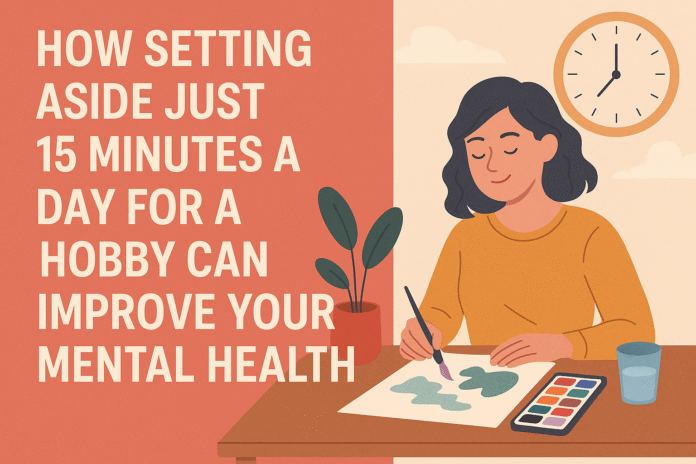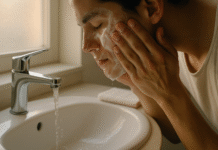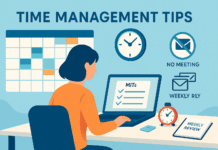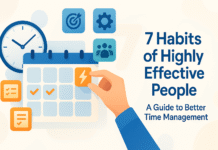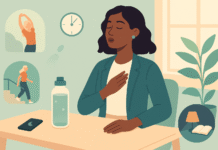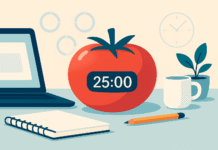It’s hard to take care of ourselves when we have a lot going on. Many of us put our personal health and happiness on hold because we have to fulfill work deadlines, take care of our families, and keep up with our social duties. But more and more studies demonstrate that even a tiny, consistent commitment, like spending 15 minutes a day doing things you enjoy, can be very healthy for your mental health. You may relax, feel better, and think more clearly by doing a pastime for a little bit each day.
This article talks about the science behind how doing something you like for a short time can benefit. It also tells you how to pick and schedule your mini-hobby sessions and shows you real-world examples of how they may make a difference in your life.
The Science Behind Short Engagement: Changing Neurochemicals
- Dopamine pathways in your brain turn on when you do things that make you happy. This makes you feel wonderful and provides you a motivation to keep going.
- Lowering Cortisol: Taking short, pleasant breaks can help lower cortisol levels. This hormone is the one that is most closely linked to stress.
- According to Attention Restoration Theory (ART), performing pleasurable tasks during short pauses can help your attention relax after being overly focused. This helps you concentrate when you get back to work.
- Microbreak Benefits: Studies in occupational psychology have shown that taking small breaks of 2 to 10 minutes to do something pleasurable will help you feel less weary and do better at work. The effects of rest will be considerably stronger if you make this longer, to 15 minutes.
A 15-Minute Activity Can Assist Your Mental Health by Lowering Your Stress Levels
- Taking a vacation from something you enjoy can help your mind stop thinking about the same things over and over and give it a break from stress.
- Things like drawing, writing in a diary fast, or listening to music can help lower your pulse rate and blood pressure in only a few minutes.
Feeling Better
Your body creates endorphins when you perform something fun or creative. These things might make you feel better. Making things or dancing for even a short time can really help.
More Work and Focus Done
A 15-minute break to clear your thoughts can help you get back to work with more focus, which will lower mistakes and raise output. The “Pomodoro Technique” argues that you can get more done if you take breaks. It advises to work for 25 minutes and then take a rest for 5 minutes. Using it for fun activities makes it even better.
More Faith in Yourself
Getting things done, even minor ones like solving a crossword puzzle, can raise your confidence, which can help you with both job and personal concerns.
When Shared, Social Connection
Spending time with friends or online groups that like the same things you do, even for just 15 minutes, can help you feel like you belong and gain the social support you need to overcome melancholy and anxiety.
Choosing the Right Hobby for 15 Minutes
Some pastimes are better for your intellect than others. Keep the following in mind when you pick your daily mini-activity:
- Personal Interest and Motivation
It’s better for you in the long term to have hobbies that you genuinely enjoy. Think about things you enjoyed to do when you were a youngster or things you’ve always wanted to do. - Requirements for Resources and Feasibility
Choose things to do that are easy to do for a short period, including drawing, brief yoga flows, listening to audiobooks, or knitting patterns that aren’t too hard. - Finding the appropriate balance between challenge and skill (Flow Zone)
The ideal level of engagement is when you have to work a little harder than you want to, but you don’t become angry. - Simple to get to
Make sure that your pastime doesn’t need a lot of labor to get started. You may have a little watercolor set on your desk or a journal next to your favorite chair where you can write down things you’re thankful for. - The ability to change
Pick pastimes that you can do in different places. You might, for instance, play puzzle games on your phone while you drive to work or work out at your standing desk.
How to Prepare for Your 15-Minute Session
- Think of your free time as “mini appointments” that you can’t miss to get the most out of it.
- Set up a schedule: Set aside 15 minutes per day when no one will bother you. This can be in the morning, afternoon, or evening.
- Get your “hobby kit” ready: Put your things in a dedicated caddy or a digital folder. This makes it easier to choose and saves time when you need to change.
- Set a timer: You can keep on track and not go over your time by using a simple countdown.
- Get rid of things that distract you: Let everyone in your house know that you need a short “do not disturb” time. Turn off notifications and dismiss any browser tabs that aren’t related.
- Think about it: Take a minute to jot down what you enjoyed and how your mood changed after each session. This can help you figure out which hobbies have the most long-term effects.
Getting Through Typical Problems
- “I’m Too Busy”
Think of 15 minutes as an investment. Many of the forts are worth more than the time spent on them since they are more practical. - Choice Paralysis
Pick three to five interests ahead of time and change them up. This variation keeps things new. - Not having enough motivation
Link your hobby time to something you already do, like brushing your teeth, to start a habit loop. - Feeling terrible about utilizing it “unproductively”
Taking care of your mental health is a big element of getting things done. Being more focused and strong helps in many areas of life.
How to Find Out What the Long-Term Effects Are
- Mood Journals: Write down how you feel on a simple 1–10 scale before and after each session.
- Stress Scales: Use methods that have been demonstrated to help, such as the Perceived Stress Scale (PSS), to rate your own stress every month.
- Productivity logs: On days when you take breaks for hobbies and days when you don’t, write down how much work you get done and how many mistakes you make.
Even brief lines like “I felt calmer today” show that you’re getting better and help you stay going with the practice.
Success Stories from Real Life
- Maria’s Mindful Drawing: A marketing manager would draw for 15 minutes every morning. She remarked that her anxiousness before work had gone down in two weeks, which allowed her think of more innovative ideas for campaigns.
- Jamal’s Micro-Meditations: A coder swapped 15 minutes of guided meditation for scrolling around social media. He felt better after his burnout symptoms became better, and he was pleased to go back to work.
- Alia’s Flash Fiction: After supper, a teacher composed short stories for 15 minutes. This activity not only made her feel better, but it also helped her tell stories better, which she employed in her courses.
In short, adding only 15 minutes of planned hobby time to your daily calendar is a surprisingly simple yet effective method to improve your mental health. Both scientific and anecdotal evidence show that making little, regular investments in happiness pays off in a huge way. These investments can affect how neurochemicals work, help you concentrate again, make you feel better, and give you greater faith in your abilities. By picking pastimes you enjoy, arranging your sessions properly, and keeping track of how you’re doing, you may turn short amounts of spare time into long-lasting health. Choose your first 15-minute task for today and learn how even little improvements may make a significant difference.
Questions That Many Individuals Have
- Do you like browsing at social media?
You may easily get to social media, but it can also make you feel horrible about yourself and pressured. Instead of just eating, choose pastimes that help you relax or come up with fresh ideas. - What if I don’t come for a day?
Don’t worry; simply think of your pastime as something you do every day. You can miss a day if you want to. It’s better to be consistent than excellent over time. - Is 15 minutes really enough?
Yes. Research on microbreaks shows that even short, focused pauses can assist your mind and emotions in ways that can be evaluated. - How can I keep going?
Change up your activities, create reminders, and write down your triumphs. People stay interested when they celebrate small wins. - Can you do hobbies with other people for 15 minutes at a time?
Yes, of course. You can cram fast video calls or language practice with a partner into a 15-minute slot, which makes it more social. - What can you do to help with your anxiety?
Mindful activities like coloring, sketching, knitting, or short guided meditations might help you relax and take your mind off of your worries. - Do I need any specific tools?
Not all the time. There are several useful hobbies that don’t require any special tools, such as journaling, stretching, and reading. - When will I start to feel better?
Some changes in mood may emerge straight away, but major ones, like feeling less worried all the time, usually arise after 2 to 4 weeks of daily practice. - Should I do my activity at the same time every day?
Being consistent helps you build habits. Choose a time that works for you most of the time, but be ready to modify it if you need to. - Are hobbies that are digital as good as those that aren’t?
Both can be useful. It’s okay to play digital puzzles or art apps as long as they don’t get too dull.
References
- American Psychological Association. The Role of Dopamine in Reward and Pleasure. https://www.apa.org/monitor/2015/05/dopamine
- Mayo Clinic. Stress Symptoms: Effects on Your Body and Behavior. https://www.mayoclinic.org/healthy-lifestyle/stress-management/in-depth/stress-symptoms/art-20050987
- Kaplan, S. (1995). “The Restorative Benefits of Nature: Toward an Integrative Framework.” Journal of Environmental Psychology, 15, 169–182. https://doi.org/10.1016/0272-4944(95)90001-2
- Trougakos, J., Hideg, I., Cheng, B., & Beal, D. (2014). “Lunch Breaks Unplugged: The Role of Autonomy and Detachment from Work in Recovery.” Journal of Applied Psychology, 99(4), 713–728. https://doi.org/10.1037/a0036012
- Healthline. 5 Simple Stress-Relief Tips You Can Use Right Now. https://www.healthline.com/health/mental-health/stress-relief
- Journal of Positive Psychology. “The Mood-Boosting Power of Creativity.” https://www.tandfonline.com/doi/full/10.1080/17439760.2019.1583343
- Bandura, A. (1997). Self-Efficacy: The Exercise of Control. W. H. Freeman.




























